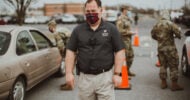Coronavirus, a.k.a. COVID-19, is lurking on the edges of the United States. What it will do here has yet to be seen. I was initially very concerned since I work on the front lines in community emergency medicine. For the last week or so, I have felt a little better after reading several articles. I suspect it will not have a high lethality among otherwise healthy individuals. But I’m no virologist and time will tell.
I do have a couple of observations.
First, we are already working with a shortage of physicians. We don’t have enough primary care physicians or specialists. Until Medicare (which funds residency training) agrees to increase the number of physicians trained after medical school, we will continue to have a shortage. Sadly, we have a fair number of young physicians who invest money and time in medical school but who can’t find residency slots. (We refer to them as “graduate physicians,” and we should find ways to use them as we use NP and PA practitioners. They have more didactic and clinical education on graduation than new NP and PA graduates have.)
This matters not only because we already have too few physicians, but because an epidemic could leave us short of more physicians, who become afflicted with the disease. Reports out of the PRC suggest that it has been hard on physicians, who are not only getting infected and sometimes dying, but also completely exhausted from their work. (Additionally rendering them more susceptible to infection.)
Another issue we have is that for a physician to work in a hospital (to be “credentialed”) can take months. Having done some credentialing lately for a new job, I can attest. A physician has mounds of paperwork to fill out and has to send copies of every kind of certification and verification imaginable, even if they’re already on file from a previous period of employment. Said physician may have to get a new state license, which is often as daunting (or more so) than what hospitals require.
Further, he or she must send driver’s licenses, passports, reports of previous lawsuits (already available online), references, sometimes fingerprints, and even explanations of more than one month without consistent work in medicine. While that may seem like a good idea to some, it can make it very difficult to move physicians to new locations in a pinch. Or in an epidemic.
We need a better way to do this in times of crisis, and I suggest that there should be a central emergency credentialing system maintained by each state, which could be agreed upon and shared. Thus, if (for example) all the physicians in a small hospital in Alabama were stricken ill, physicians from Pennsylvania could be allowed to come and work, and this could be accomplished with a click and a file transfer.
States are already working on interstate licensing; that’s great. We also need inter-hospital credentialing, so that physicians who have the time off, or who are semi-retired (or fully retired) can get into the fray.
As an aside, we should develop a better, more uniform way to use those graduate physicians I mentioned above who would be more than willing to fill in and learn, and get paid, in times of crisis.
Second, hospitals during flu season are already at capacity. If we have a Coronavirus outbreak, patients from primary care offices, clinics, and urgent care facilities, as well as self-triaged concerned citizens, will show up in hospital emergency departments in large numbers, potentially serving as hubs for spread of infection.
The answer to every question in an office or clinic, on a phone-triage line or telemedicine site simply can’t be “just go to the ER,” because the ER will be beyond capacity. (As will the inpatient side of the hospital.) Furthermore, what might be a simple head cold could well become worse if exposed to the sicker patients in the ER waiting room and treatment areas.
This might require some modification of EMTALA, the “anti-dumping” law that mandates that everyone be seen regardless of ability to pay. Not in order to extract money but in order to sometimes say “you aren’t dangerously ill, we don’t have time or space to see you, go home and avoid crowds, and come back if you’re worse.”
Finally, we need to support America’s small and medium hospitals outside urban areas. They could serve as a relief in times of great national distress. Rest assured, in a pandemic the big hospital teaching centers will be full and more than full. Strategically, America needs the option of vibrant, well-staffed smaller hospitals in suburban and rural communities. Not only for epidemics but for natural disasters, terrorism or open warfare. (No, I’m not paranoid. Peace and safety are rarities in history.)
I pray COVID-19 dies a rapid death. But if it doesn’t, we have work to do. We just don’t have the staff or capacity we’ll need in case it continues its inaugural journey around the world.
Edwin Leap is an emergency physician who blogs at edwinleap.com and is the author of the Practice Test and Life in Emergistan.
Image credit: Shutterstock.com























